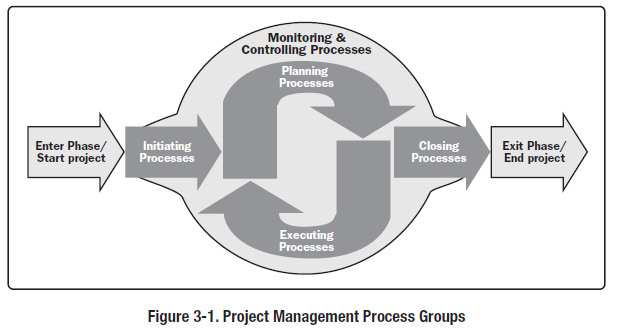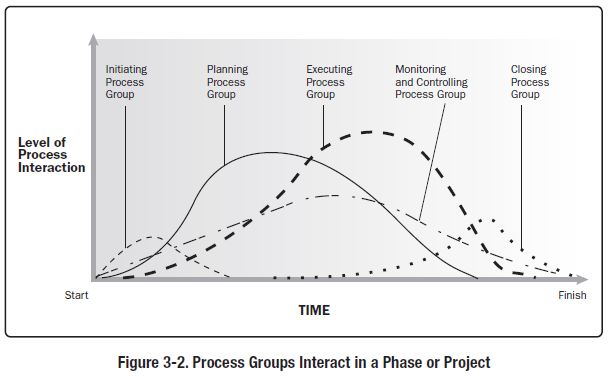Today I’ve finished the 3rd and 4th videos of the series:
- Project Management Process.
- Project Integrated Management.
Worth mentioning; after 2 days of studying CAPM, my view of the subject changed and I started to love it.
And here are my notes for the two lectures.
Project Management Processes
This covers Ch. 3 from the PMBOK.
Project management processes = same as Project life cycles.
- Initiating = validating that the we are doing the right project.
- Planning = it’s very critical to the succcess of the project.
- Executing = deliver take place.
- Monitoring and Controlling = PM take place.
- Closing.
Project Management Process:

Notes on the Figure:
- Notice that Initiating is stand alone process.
- Planning and Executing take place together.
- Planning take place during all time of the project, there is a high level of planning at the beginning but it continues through all the project, because CHANGES ARE INEVITABLE >>> we need to plan on how to deal with the problems and changes during the project.
- Execute and Planning goes together and affect the scope and time of course.
- Monitoring and Controlling (PM job) also almost all the time of the project.
The next figure gives a better idea on how the previous processes overlap:
- Initiating again is a stand alone process at the beginning of the project, it’s short and intense. And here we validate that we are doing the right project.
- In theory we finish Initiating and proceed to Planning, but in practice planning start after we start initiating assuming we are doing a valid project. So Planning start after we start Initiating.
- Monitoring and Controlling all other processes.
- In reality also some Executing starts while we are planning.
Initiating:
- Develop Project Charter.
- Identify Stakeholders.
- Identify Success Criteria.
Project Charter:
It’s a PMI Must. And it Identifies:
- The Business Needs.
- Concerns.
- Values of the project.
In short (this is why this project it important, why it makes sense).
Project Charter = Foundation for Approval and all future works.
Stakeholders:
- Business owners = who have the business Needs. In other words who is experiencing the business pain that this project will solve.
- Project Sponsers.
- Project Acceptors.
- Project Team.
- Other Parties.
Any one in/out the organization who cares about the project. We need to identify the owners motivations here, i.e. what are their motivators? Is it time, cost, scope? (ex. we need to finish before Christmas to use the shopping rush = time).
So future decisions must satisfy these motivations.
Success Criteria:
- How we measure Success.
- The Project will be completed when the following criteria are accomplished.
Planning:
The most important key to success. It’s the only PM Process that covers all (9) Areas of Knowledge (Scope, Time, Budget…).
Project Management Plan: is both key and Significant to the project. And it focuses on:
- WBS (Work, Break, Structure). Identify the work required to satisfy the requirements and Deliverables.
- Budget.
- Schedule.
- Quality…
And it’s fully integrated, continuous plan. Heavy at front but take place all the time of the project.
Executing:
- The easiest, limited PM process. Here the team do the most work and the PM monitor and control.
- Project Deliverables are produced.
- Follow Industry Approaches (like if we are building a house, software >>> there will be an industry approaches to follow).
- Removal of Road Blocks (PM job): Issues that prevent the team from executing (no access to resources…)
- Manage Communication (PM job): Keep Stakeholders informed.
Monitoring and Controlling:
All PM.
Monitor and Control:
- Schedule (are we on time?).
- Scope (are we delivering all the work?).
- Budget.
Control Change:
- Change Happens, and we need to decide the impact of this change on everything (Scope, Time, Budget, HR…).
- Reprot Perfomance (are we still on time, on scope, on budget? or under or ahead?).
Closing:
- Closing the Project. Getting the final acceptance on the deliverables (ex. holding the keys to the owner).
- Lessons Learned: what worked well, what not, what we will repeat and what we will improve.
- Harness Artifacts: value added.
Project Integrated Management
The Integration of All other Areas of Knowledge.
- Develop Project Charter.
- Develop Project Management Plan.
- Direct and Manage Project Execution.
- Monitor and Control.
- + Perform Integrated Change Control.
- Close the Project OR Phase.
Develop Project Charter:
- Formal Authorization, you present the charter and gain the gain the approval.
- Project Charter:
- Business Case: what we need, the Justifications.
- Cost\Benefit.
Project Charter Content Example:
- Executive Summary (for those who have no time to read it all).
- Project Sponsors and Key Stakeholders.
- Business Case.
- Objective and Success Criteria.
- High level Cost\Benefit analysis.
- Risk Assessment.
- Assumptions and Constraints.
We get the Approval and then we move to >>> Plan.
Project Management Plan:
- PM Plan is foundation document for success.
- Covers ALL (9) Areas of Knowledge.
- Identifies Acceptance and Criteria.
Remember you are planning for achieving the Criteria but more for the COMPLETION of the Project.
Project Management Plan Content:
With names more general to the public.
- Executive Summary.
- Project Goals. (Project Charter)
- Project Organization Chart. (Key Stakeholders)
- Project Deliverables.
- Project Scope\Boundaries.
- Success Criteria. (All 4+5+6 = Scope)
- Project Schedule. (Time)
- Project Budget. (Budget)
- Quality Plan. (Quality)
- Staffing Plan. (HR)
- Risks and Issues. (Risk)
- Communication Plan. (Communication)
- Procurement Plan. (Procurement)
- Change Management Procedures.
- Assumptions and Constraints.
Direct and Manage Project Execution:
- Produce Project Deliverables.
- Quality Assurance.
- Mange Acceptance (of the deliverables by the owners).
- Facilitate Progress = Removal of Blocks.
Monitor and Control Project Work:
- PM.
- Track and Manage Schedule (Proactively).
- Track and Manage Budget (Proactively).
- Managing Risks.
- Report Status.
- Manage Stakeholders (manage their expectations).
Project Weekly status Report:
What I was able to accomplish: …..
What I wasn’t able to accomplish: …..
Unplanned work accomplished: …..
What I plan to do next: …..
Problems/Issues/Warnings: …..
Project Monthly Report (to Senior Executive):
Major Accomplishments this month: …..
Financial Status: (In more details)
Total Budget: …
Spending to date: …
Estimate to complete: …
Variance: …
Project Schedule:
Effort expected to date: …
Remaining effort: …
% Completion: …
Major Issues: …..
We get the approval and move on to our next process.
Perform Integrated Change Control:
We’ve already discuss the concept, here we discuss the mechanics:
- Identify and Qualify and Document all changes. Any change happen we need to identify and qualify and document it.
- Approval to all changes in: Scope, Time, Budget…
- Update Project Baseline, based on the changes and our evaluations.
Project Change Request:
Reasons for Change: …..
Description of Change: ….. (Team do it).
Cost Amount: …..
Ramifications (on schedule, staff…): …..
Close Project OR PHASE:
- Obtain Acceptance (that we did the job).
- Harvest Lessons Learned.
- Reusable Materials.
- SECURE Approval to Next Phase: after finishing Analysis we move to >>> Design (same steps then) >>> Development. (PHASE GATE APPROVAL).
